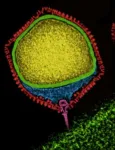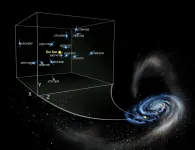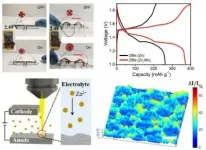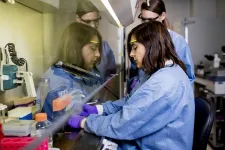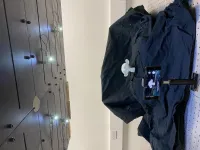(Press-News.org) Nothing in biology is static. Biological processes fluctuate over time, and if we are to put together an accurate picture of cells, tissues, organs etc., we have to take into account their temporal patterns. In fact, this effort has given rise to an entire field of study known as "chronobiology".
The liver is a prime example. Everything we eat or drink is eventually processed there to separate nutrients from waste and regulate the body's metabolic balance. In fact, the liver as a whole is extensively time-regulated, and this pattern is orchestrated by the so-called circadian clock, our body's internal metronome, as well as biochemical signals and eating rhythms.
But the liver is actually divided into small repeating units called "lobules", in which distinct zones perform different functions. This intricate spatial organization is known as "liver zonation". For example, the breakdown of sugars during digestion takes place preferentially on one side of the lobule, the so-called central zone, while the production of glucose while we rest from stores such as fat, occurs on the other side of the liver, at the portal side.
So far, liver zonation has only been studied statically, looking into what each zone does independently of time, and vice-versa. And given how central the liver is in mammalian physiology, the two research approaches have to join efforts to understand how temporal and spatial liver programs interact.
In a first ever study, scientists at EPFL and the Weizmann Institute of Science, led by Professors Felix Naef at EPFL's School of Life Sciences and Shalev Itzkovitz at the Weizmann, have been able to monitor the spatial shifts of gene expression within liver lobules in relationship to the circadian clock. Studying this link is a focus of Naef's research, which has previously uncovered connections between the circadian clock and the liver's proteins, our cell cycles, and even the 3D structure of chromatin, the tightly packaged DNA in the cell nucleus.
The study came out of a EPFL-Weizmann joint grant from the Rothschild Caesarea Foundation.
By exploiting the ability to analyze liver tissue in every individual cell, the researchers studied approximately 5000 genes in liver cells at several timepoints throughout the 24-hour day. They then statistically classified the space-time patterns they uncovered with a model that can capture both spatial and temporal variations in the levels of messenger RNA (mRNA), a marker of gene expression.
The study revealed that many of the liver's genes seem to be both zonated and rhythmic, meaning that they are regulated by both their location in the liver and the time of the day. These dually regulated genes are mostly linked to key functions of the liver, e.g. the metabolism of lipids, carbohydrates, and amino acids, but also include a few genes that have never been associated with metabolism, e.g. genes related to chaperone proteins, which help other biomolecules change their 3D structure or even assemble and disassemble.
"The work reveals a richness of space-time gene expression dynamics of the liver, and shows how compartmentalization of liver function in both space and time is hallmark of metabolic activity in the mammalian liver," says Felix Naef.
INFORMATION:
EAST LANSING, Mich. - Michigan State University is leading a global research effort to offer the first worldwide view of how climate change could affect water availability and drought severity in the decades to come.
By the late 21st century, global land area and population facing extreme droughts could more than double -- increasing from 3% during 1976-2005 to 7%-8%, according to Yadu Pokhrel, associate professor of civil and environmental engineering in MSU's College of Engineering, and lead author of the research published in Nature Climate Change.
"More and more people will suffer from extreme droughts if a medium-to-high level of global warming ...
Researchers at Columbia University Mailman School of Public Health developed an infectious disease early warning system that includes areas lacking health clinics participating in infectious disease surveillance. The approach compensates for existing gaps by optimally assigning surveillance sites that support better observation and prediction of the spread of an outbreak, including to areas remaining without surveillance. Details are published in the journal Nature Communications.
The research team, including Jeffrey Shaman and Sen Pei, have been at the forefront of forecasting and analyzing the spread of COVID-19. Their ...
Fast facts:
This study describes essential differences between marine and freshwater species and the contributions of viruses to such differences
The results may help guide future bioengineering efforts to develop plant strains adapted to grow in salt-water, which is of local and regional food security interest
Microalgae are fundamental to global ecosystems due to their ability to sustain coral reef species and produce atmospheric oxygen
Before this study, many important algal phyla did not have sequenced representatives
Viruses have contributed to the evolution of algae and their genome makeups
Abu Dhabi, UAE, January 11, 2021: NYU Abu Dhabi (NYUAD) ...
It is well known that the expansion of the universe is accelerating due to a mysterious dark energy. Within galaxies, stars also experience an acceleration, though this is due to some combination of dark matter and the stellar density. In a new study to be published in Astrophysical Journal Letters researchers have now obtained the first direct measurement of the average acceleration taking place within our home galaxy, the Milky Way. Led by Sukanya Chakrabarti at the Institute for Advanced Study with collaborators from Rochester Institute of Technology, University of Rochester, and ...
Moms are not more likely than other women to support gun control efforts. In fact, a new study finds that parenthood doesn't have a substantial effect on the gun control views of men or women.
"Everybody 'knows' that moms are more politically liberal on gun control issues," says Steven Greene, corresponding author of the study and a professor of political science at North Carolina State University. "We wanted to know if that's actually true. And, as it turns out, it's not true - which was surprising."
To explore the impact of parenthood on people's gun control views, the researchers drew on data collected by the Pew Center for Research in 2017 as part of Pew's nationally ...
Lithium-ion batteries are critical for modern life, from powering our laptops and cell phones to those new holiday toys. But there is a safety risk - the batteries can catch fire.
Zinc-based aqueous batteries avoid the fire hazard by using a water-based electrolyte instead of the conventional chemical solvent. However, uncontrolled dendrite growth limits their ability to provide the high performance and long life needed for practical applications.
Now researchers have reported in Nature Communications that a new 3D zinc-manganese nano-alloy anode has overcome the limitations, resulting in a stable, high-performance, dendrite-free aqueous battery using seawater ...
In diseases characterized by bone loss -such as periodontitis, rheumatoid arthritis, and osteoporosis- there is a lot that scientists still don't understand. What is the role of the immune response in the process? What happens to the regulatory mechanisms that protect bone?
In a paper published recently in Scientific Reports, researchers from the Forsyth Institute and the Universidad de Chile describe a mechanism that unlocks a piece of the puzzle. Looking at periodontal disease in a mouse model, scientists found that a specific type of T cell, known as regulatory T cells, start behaving in unexpected ways. These cells lose their ability to regulate bone ...
WASHINGTON -- As LEDs replace traditional lighting systems, they bring more smart capabilities to everyday lighting. While you might use your smartphone to dim LED lighting at home, researchers have taken this further by tapping into dynamically controlled LEDs to create a simple illumination system for 3D imaging.
"Current video surveillance systems such as the ones used for public transport rely on cameras that provide only 2D information," said Emma Le Francois, a doctoral student in the research group led by Martin Dawson, Johannes Herrnsdorf and Michael Strain at the University of Strathclyde in the ...
BUFFALO, N.Y. -- Scientists have known for years that mutations in the MLL4 gene can cause Kabuki syndrome, a rare developmental disorder.
But a study published on Jan. 11 in Nature Communications illuminates new details regarding how this occurs. (Images are available by contacting Charlotte Hsu in UB Media Relations at chsu22@buffalo.edu.)
The research suggests that MLL4 controls the production of neurons that secrete growth hormone-releasing hormone (GHRH) in a part of the brain called the hypothalamus. Mice without working copies of the MLL4 gene in this area had stunted growth and markedly fewer GHRH neurons. Mice with only one functioning ...
CLEVELAND - As reported in Nature Communications, researchers from Cleveland Clinic's Lerner Research Institute have developed a novel, patient-derived model of ulcerative colitis, which will help advance studies into new treatments for the chronic inflammatory bowel disease.
The team used the model to identify a promising target that could be inhibited to slow disease progression.
Ulcerative colitis is characterized by abnormal reactions of the immune system that lead to inflammation and ulcers on the inner lining of the large intestines. It is a highly heterogeneous condition, both in terms of patients' symptoms and disease pathology.
Suppressing the overactive immune response with anti-inflammatory drugs is the current ...
